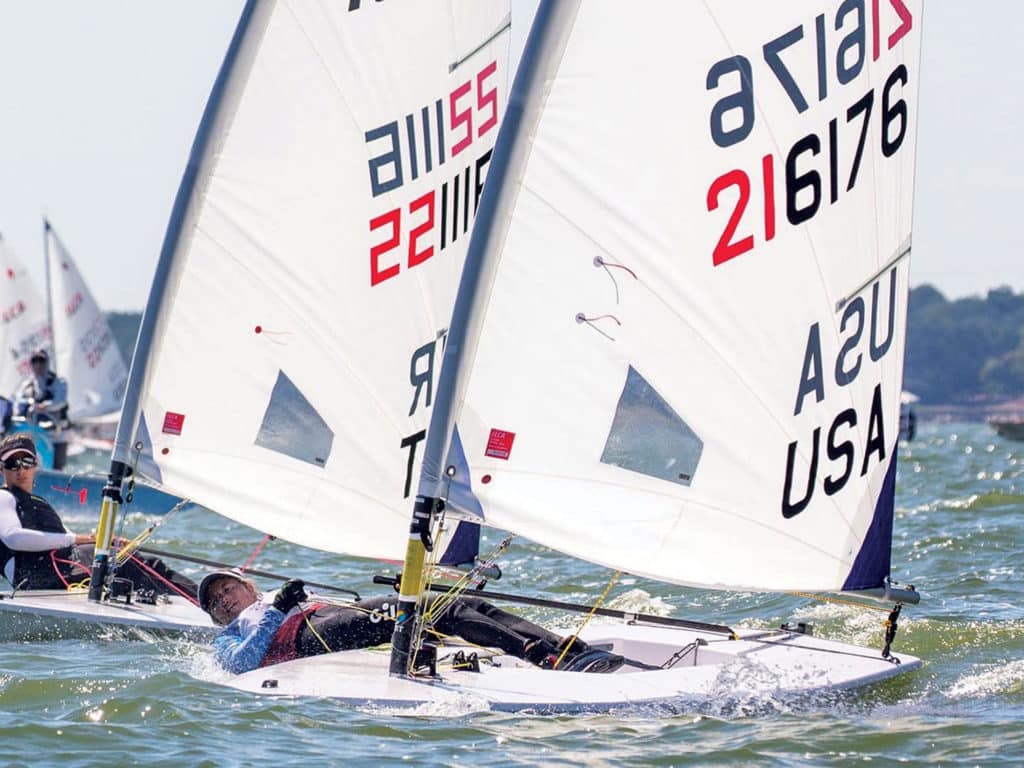
After two years of campaigning the Olympic 49erFX, I recently returned to the Laser Radial (now known as the ILCA 6), and my enthusiasm for speed was ripe on one day of training in Fort Lauderdale. With the breeze pumping at 18 knots, I trimmed the sail for the first lineup of the day, feeling the load in the deck and the power in my quads. Then, with a big smile on my face, I eased the mainsheet 5 feet or so and let the boat rip. It felt awesome until I heard my coach, Erik Bowers, yell at me from the RIB, “Erika, it’s not a skiff! The boat’s not going to take off. Bring it back up!”
As much as I was enjoying essentially reaching around, Bower’s reality check was a good reminder for me to recalibrate what we all call moding, which is sailing the best angle for the given wind strength. The top sailors know how and when to shift between three different modes: high mode, velocity made good (VMG) and low mode. Each mode has its unique features and applications on the racecourse, but the key to speed is to select the correct one at the right time, so let’s explore how.
On an upwind leg, consider your high mode as the closest angle you can sail to the wind without the luff of the sail starting to break. Your best indicators in this mode are the windward telltales dropping slightly and the leeward ones streaming straight back. This mode sacrifices some forward speed and is similar to walking a tightrope; you have to balance speed versus height, and the sea state is especially critical because one small error in sheeting or steering will make you “fall off the rope” immediately.
The VMG mode is defined as the quickest way to make distance toward the mark. In other words, this can also be thought of as the best average speed toward the mark. This mode is a bit more forgiving because its boundaries are somewhere between the high and low modes. Oftentimes, true VMG touches both modes as you sail upwind.
The low mode is just below your VMG angle and somewhere above tight reaching. Placing the boat in this mode increases the load in your sail(s) and hull appendages, thus increasing your overall boatspeed. However, if there’s too much force over the sails and the underwater foils, drag increases and your boatspeed drops. Finding a low-mode sweet spot is important because having the same speed but sailing a lower angle than another competitor on an upwind beat never produces a good outcome.
Understanding the limitations of each mode is critical, but knowing when to exploit specific modes in different wind strengths is how the best sailors win the boatspeed race. For example, in light air, a high mode always trumps a low mode because sailing a lower angle doesn’t create fast-forward speed toward the mark. Thus, in underpowered conditions, the objective is to go the same speed and higher than other boats. When the wind increases in velocity, the challenge becomes finding the shifting point from forward speed in a low mode to optimal VMG. How to get to this point is different for every boat in different wind strengths and sea states. In the ILCA 6, for example, the transition to a low mode becomes favorable at about 13 knots. At this wind strength, the boat is able to pick up enough speed to overcome the benefits of a high mode. In the 49erFX, this crossover happens much lower in the wind range. At around 8 knots, or when both skipper and crew are fully trapping, the skiff wants to take off and tap into apparent wind sailing. During 49erFX races, it’s easy to identify boats stuck in a high mode off the starting line as they immediately drop back because the speed difference between high and low modes is colossal. In this case, the low mode produces the optimal height toward the mark without sacrificing speed.
Races are most often sailed in transitional wind strengths. On a single upwind beat, there can be moments where the high mode is the dominant VMG, and then a 1- to 2-knot puff causes the low mode to take command. The skill is realizing the subtle change in wind strength and instantly adjusting your mode while considering your tactics. A good rule of thumb is that your high mode will be your best VMG until your low mode becomes significant enough to be a real boatspeed weapon. For example, if you’re able to put the bow down to then promptly tack and get a cross in, the low mode becomes the best VMG to the weather mark.
Using relatives from other boats to check in with your mode selection during a race is extremely helpful for deciding which mode to maintain. The sailors on top of the results page have their mode selection dialed in. Though practicing these nuances before an event is great, the best VMG angle for a race can easily be determined during the pre-start. Going upwind and teasing the extremes of each mode only takes a few minutes, and testing what you find against another boat will confirm or deny your hunch. No matter what, establish a feel for the limitations of each mode. Once you have a good feel for them, find your room to play.









